Learn More About Your UK Carnival Mas Bands: Bacchanalia
Hi Bacchanalia
We appreciate the work you have put into the scene over the years to carnival and the Caribbean culture. We think it is about time more of the community got to know more about your mas band.
1.Please tell us your origins, what your band name is, and how long you have been operating as a mas band?
I am of Trinidadian descent, carnival has been all around me since birth. If you are a creative, there is no better place to grow up than surrounded by mas, makers of mas and all that living creativity.
Bacchanalia Mas Band was incepted in 2005 – we launched the band with the ethos of bringing friends and family together, to create a space where people feel welcome, make new friends and learn about carnival. We are very proud of the work we are doing and have been successful so far in achieving our goals as our ‘family’ has been growing over the years.
2. Are you Self-funded or Council-funded and how do you retain costs?
Bacchanalia is a self-funded band. Council funding is an option we are currently exploring however, that comes with its own constraints. Bringing out a band like ours costs on average £40k – no small amount of money. This is to secure floats for the day, drinks, security, sound systems, dj’s and sound engineers, materials for costumes (which is a whole separate topic), insurance, mas camp, etc. These are not small costs and in order to have a successful event, all must be catered to.
Bringing out a band is no small feat – there are many things to consider than just costumes – you are literally managing an entire production – over the course of a year – usually whilst doing a full time job alongside it.
Our costumes are very detailed and made with the best materials. We have branded ourselves as a premium all-inclusive band – which means everything mentioned earlier is included in the cost of the costume package. This source of funds does not cover the entire production and we are usually footing a chunk of the bill out of our own pockets.
3. What separates your band from other bands and what do you offer to members?
Deliverability and Service. We spend a lot of time with our masqueraders – both in and outside of the carnival arena. The network has grown so much and it makes me extremely proud when I see real bonds of friendships emerge out of it. We also dedicate time to our new masqueraders – invite them to camp, introduce them to the team and welcome them on board fully – they learn about how the costumes are made and usually end up helping out as well – especially as a lot of our masqueraders are new to carnival overall. As I mentioned above, we are an all-inclusive band so everything is included in the price of the package. We have a fantastic team in place and we work very well together.

4. What is mas and in your opinion what is carnival about? In your eyes how has carnival evolved?
Mas and carnival are in my eyes moving theatre – it’s a story, a performance, a creative way of telling our history. It’s the culmination of many different forms of talent coming together to create a spectacular platform of creativity, of moving images, of colour, of both the ugly and the pretty, an expression, a footprint.
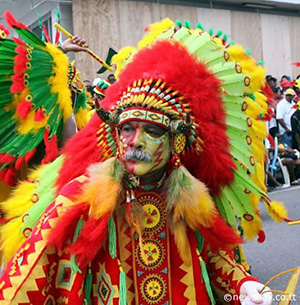
Lionel Jagessar Mas – Photo Credit Newsday TT
Today, carnival is a very different beast. It now caters to the masses that flood to Trinidad who are out to have a good time in the sun and adorn themselves in sparkly creations – which in itself also has its place. Few bands now do traditional portrayals. We, Bacchanalia are actually doing something a little more traditional next year.
One of my favourite camps in Trinidad is that of Lionel Jagessar – they do Fancy Indian Mas – my all time favourite costume (so yes, this will feature next year too and that is a huge hint of things to come).
But I deviate, the story-tellers of long ago did not have the social mediums we have access to today – Facebook, Twitter, Youtube etc and therefore their work and images were seen in limited formats. Sometimes, you just had to be there. Today, carnival especially in Trinidad is what sells – tourists and returning locals flock to the island that is electric with carnival fever the minute you step off that plane and breathe in the warm air. The whole country feels it.
Costumes are now not locally made either, they are mass produced in India, China, Thailand where the labour is cheap and if I am being honest, they actually want the work. The production teams in Trinidad are faced with higher costs if they were to employ locals and the skillset is just not there anymore as it is not being passed on. When you see that generation of skilled men and women passing away, its frightening to think that no one is going to be able to do what they did. There are only a small handful of skilled mas men left in Trinidad – I have spoken to a few or had the privilege to meet them and a few voiced ambitions of writing books etc so there is some hope.
5. In your eyes how has carnival evolved?
Carnival has become an industry – while there is nothing wrong with this, where I feel there is a problem, is that the history behind it, where it came from and what it means is not being passed on. Masqueraders are simply buying a package and wearing a costume – not knowing what any of it means – or the significance of carnival to Trinidad itself. We are often compared to Brazil now – and yet even past the few Samba Queens at the front of each Samba School, there are some rather detailed and intricate costumes behind the float – which no one pays attention to. I am aware that a few friends of mine indicated that U.W.I were doing carnival degrees so maybe there is still hope for it to be taught to the next generation.
6. Pretty mas or Ole Mas and why?
Both – I think you can’t have one without the other. Pretty mas is the evolution of ole mas and to some extent should be a more future looking way of looking at mas. Ole mas tells a story – it tells us where we came from, the story of our ancestors and their journey, it tells us of folklore, of history, of good and bad times, of what life was like back in the day of our parents and grandparents. It’s an amazing footprint of who we are.
Pretty mas on the other hand, is where we are going – with more focus on fashion and a new look rather than any cultural attachments associated with it. What is powerful is if you marry those two elements – I have only seen one or two bands do this successfully and the portrayal was quite a powerful one. For 2014, we are going back to our roots and doing something a little more traditional. Bands are faced with several dilemmas when coming out with a theme – supply and demand being key. Sometimes as a designer, you have to bow to demand and the demand is biased towards pretty mas.
7. What is your definition of an all-inclusive mas band?
All inclusive means everything you could possibly need for your experience is included in the price package you pay. This includes and is not limited to: costumes, food (lunch and breakfast), security, sound, DJ’s, floats, drinks (both soft drinks and alcohol), goodie bags, service teams and staff – all the things and added extras that make your experience the most awesome where the only thing you have to concentrate on – is having fun!
8. What is important to you as a band; retaining the culture and teaching members about the history of carnival, artistic showcase of your designs or monetary gain to reap profits and sustain yourself and why?
It is important to me personally to retain our culture especially when it comes to carnival as this is the medium I use to express myself. I have a deep love for it – the story, the mas makers of my time and its sad to think that the generation that created some of the most amazing costumes in the world would have passed by and not many people outside of Trinidad would have known about them or their work. In the run up to carnival, to keep interest and to do some small teach-ins, we host quizzes and games around the carnival – showing pictures of dimanche gras over the years and some of the work that is churned out. Carnival is not just a two day affair on the streets of Notting Hill – carnival costumes were used to open the Olympics, they are used in the theatre, they are used as part of art exhibits and museums, in fashion, in worldwide festivals and shows. It is important that the place and culture that produced this be recognised – no other place in the world, except Brazil, works like us when it comes to carnival.
9. Do you cater to families with children and how do you ensure their safety on the road?
For Notting Hill, we do not cater to kids – we do not yet feel we are ready to open the band to kids on such a long route. Whilst we do have past experience of this, we have opted to have kids be a part of our regional carnivals instead. We’ve been invited by a number of schools to come in to do workshops and teach the kids how to make basic costumes. However, there are not enough hours in the day to facilitate all these requests alongside a full time job so we are working out ways where this may be more possible on a full time basis.
10. Why has the cost of band launches soared in the last few years?
Materials and the cost of everything involved for carnival has gone up in price. That price has to then be reflected to the masquerader. Band launches are very expensive affairs. Sourcing a venue with a bar spend that is affordable, located centrally, with a 3 or 4 am finish is no longer an easy feat. Over the last few years, we’ve watched bar spends go from 2-3k to 5-6k – an astronomical amount! Especially as launches are fairly small with 100-200 people attending. One of the biggest challenges with a band launch is meeting the bar spend – as more often than not, you are limited in your marketing (marketing to the same small core group whose average age and target spend will not help in covering the bar minimum), limited in your resources and limited in the choice of venue. Once again, I will stress, carnival and carnival production is no easy or cheap affair –a lot of time, effort, money and skills go into it and I applaud and respect the bands out there who come out year after year despite struggling though the year to showcase their work and mas.
11. Besides carnival are you involved in other events nationally and abroad?
We brought out a section for the first time in Trinidad for the carnival earlier this year. This was an exciting experience for us and the costume was very well received. I was quite pleased that our band members from here who play mas in Trinidad were out there supporting us and showing the world our work. We are looking to continue this going forward. We are not always able to participate in international events as Andrew and I both work full-time.
12. In this ever growing and competitive market how do you keep and retain existing customers’ happy and satisfied whilst attempting to gain new ones?
I work in customer service as does Andrew. We spend a lot of time with our teams discussing how things can be better and where we can improve. Our masqueraders usually make suggestions too and we make a conscientious effort to engage in conversations with all. This is a very time-consuming way of doing things but these are the people that make us who we are, who we work and play with and who are the most important – they are Bacchanalia so their views and opinions are important.
We participate in a lot of corporate events, this allows us access to new crowds and groups who are always fascinated with the costumes and want to be a part of it. A lot of our new masqueraders are also friends of the people who currently play with us – there is no stronger recommendation sometimes than word of mouth! We have taken in a record amount of newbies for 2013 and we look forward to having them learn more about our mas and culture and to let their friends know about it too.
13. What often drives your motivation to design new designs and how do you remain innovative whilst staying true to mas?
Easy question – I have always been interested in fashion. At a young age, I designed a lot of my own clothes and had it tailor made in Trinidad – this was a very easy thing to accomplish as seamstresses were skilled and easily found. Now it’s a bit more difficult as I am in the UK.
Firstly and foremost, the theme is what drives me – if I am excited by the story, I would have immediate ideas on how certain costumes should look. I love to experiment and try new things. Last year, I did the two-colour feathers that was used in one of my frontline costumes – this year I am using it on an entire section. Colours, movies, books and magazines are also a huge source of inspiration and provide a wealth of knowledge.
My biggest ideas stream from Trinidad itself as I work alongside some very talented individuals out there – wire-benders, airbrush artists, make-up artists etc. Simply watching them at work is a source of inspiration. Then you take all these ideas and collages and put it together in a costume – I always go back and look at the older costumes before I start any work – to remind myself of how mas was and to ask myself if I can take it to another level. A lot of my work is extremely detailed and I try to use materials not yet used or made/designed by me or Andrew. We are constantly doing research on new ways to do things – this year I learned about paper sculpting and want to work on a costume made up purely of folded paper – not for carnival of course as it would probably last for a few minutes! We have a few things planned where ‘carnival pieces’ will be exhibited to a broader audience later this year.
14. How do you ensure you provide the best possible service to members?
We do this by keeping the doors of communication open with our teams and masqueraders. I can safely say Andrew and I know all our masqueraders and interact with them on a regular basis – not just at carnival but during the year. We host small events to keep the group together and to allow new people to join in and to learn from them also – what their perceptions are and how we can go about changing things so others don’t feel the same. Also, after each carnival, we sit with the team and do a review of what worked on the road and what didn’t and how we can improve things the following year.
15. What is your 2013 theme and sections?
Our 2013 theme is Species: Evolution. A story of what humans could evolve to in about 200 million years. I wanted to do something fun and sci-fi related and this story allowed me to be a little more creative than usual.
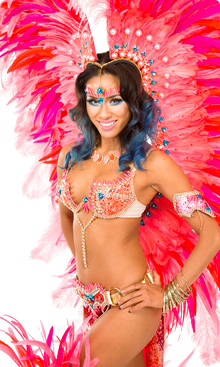 Section 1: Oracle
, Colours: Coral, Turquoise, White
Section 1: Oracle
, Colours: Coral, Turquoise, White
Humans who have achieved a higher level of sentience. These were the first to have broken off from mainstream society and join an elite group that could see into the future. The pre-cog phenomena only occurred in a select handful of women and they are identified by a small marking on their forehead that resembles a third eye.
Section 2: Cyborg Warriors, Colours: Black, Silver, Neon Yellow
Over the course of humanity, there have been so many wars and destruction. Man was able to blend parts of his body with cybernetic parts and operate it from a console. This struggle between man and machine went on for a few hundred years until very little humanity was left in the human body. This being was ideally created to be an indestructible warrior but over time when less morality and compassion was exhibited, the thousands that were created were banished to the barren corners of the earth – where they breeded – half human, half machine children. They continue to fight themselves and their own existence and are at war with all other species.
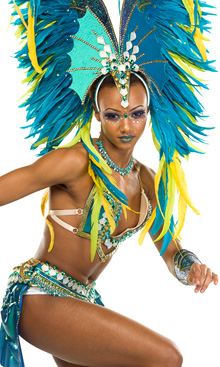 Section 3: Moken Saru – People of the Sea: Colours: Turquoise, Yellow, Emerald Green, Bronze
Section 3: Moken Saru – People of the Sea: Colours: Turquoise, Yellow, Emerald Green, Bronze
Over 200 million years ago, small tribes around Indonesia were discovered as being able to breathe in the water for long periods of time. When the war that would split the species took place, they took their families and took to the water – living and breathing on both the surface and in the water. As the planet’s surface became a barren land and water was our main source of life – the Moken Saru tribes grew to become one of the biggest segments of the population. Their skin became translucent and small gills emerged behind their ears. With each generation, their children became more attuned to the water and life beneath it. While they generally still hold human form, in the water, they closely resemble a mythical creature of long ago – mermaids. These people are peaceful and are afraid of the surface and all that lives there.
Section 4: Tiamut – People born of the Dragons: Colours: Red, Teal, Gold
Reptilian beings who have established small colonies on the opposite side of the earth from the Cyborgs. They live in small groups and have amphibian-like features and are semi-aquatic in nature. These were originally part of the Moken Saru tribes but their aggressive personalities pushed them back on to the land where they reptilian DNA created a genetic anomaly allowing them to grow wings from their backs resembling that of a dragon. The Tiamut can breathe in water but it must return to the surface for air. They occupy all of inland earth near rivers, lakes and large expanses of water. They are fierce and are the largest built of all the species.
Take A Look At Bacchanalia’s Band Launches
16. How easy is it for new members to sign up and get access to information?
Very easy – our website provides all the information one needs on joining the band and what that entails www.baccmas.com. We are also on Facebook, Instagram and Twitter. We issue regular newlsetters in the run up to carnival and an information pack is placed in each masqueraders package.
17. What other services do you offer besides the opportunity to jump up with you during carnival?
We are working with a few regional carnivals and this would allow our masqueraders to wear their costumes again during the year. We also work with a lot of corporates who hire us to showcase carnival costumes at their events. We are the preferred partner of the Trinidad and Tobago Tourist Board and this allows us to go to various events and talk to people about Trinidad, carnival, our heritage and roots. One of the partners in the Band – Ian Burrell (famously known as the Rum Ambassador) also hosts a unique event in London – Rumfest and we participate in that with our masqueraders – adding a carnival vibe and atmosphere to the event.
18. What is your most important goal as a mas band?
We’ve come back full circle with this point – our most important goal is bringing friends and family together and creating a hub of creativity that allows people to momentarily escape from the stress of everyday life and come out and meet new people while creating something that is self-made and fantastic.
Don’t get me wrong – carnival is not without its own stresses, but the opportunity to come together in a fun environment with people from all different backgrounds and ages and make mas, take photos, play music, dance and entertain, cook, cut, draw, paint etc is one that I have not been able to source in any other way – it is extremely satisfying when you walk through the band on carnival Monday and you talk to your masqueraders and they are so psyched at the whole event especially as we have ‘hug-outs’ where we hug and say to each other ‘we did it! Look what you helped to create’ – it’s an amazing feeling and one we are very proud to share with our team.
On a slightly separate note, we spend a lot of time – all year – talking to people about carnival – to change perception that carnival is a West Indian affair or a Trinidadian affair – if you do some research, there are carnivals all over the world and the earliest ones were right here in Europe! I always say to people you started it, we took it, revolutionized it and brought it back to the streets of London so it is not just our thing – it belongs to all of us so don’t just spectate, participate!
There are a number of fantastic mas bands out there who are doing exceptional work and what we all need to do as a collective is help in raising the barriers to entry – it is difficult getting information on bands, how to join etc as we market to ourselves. Lack of funding is also a huge deterrent in marketing and growth of the carnival so any sort of media and publicity surrounding the carnival should also include information on how one can join in – I am sure if the doors opened up, growth in participation will be exponential.
By Kelly & Andrew Rajpaulsingh – Owners of Bacchanalia Mas Band


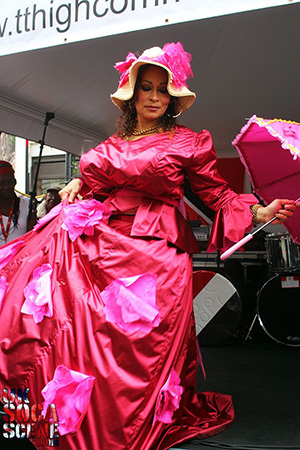
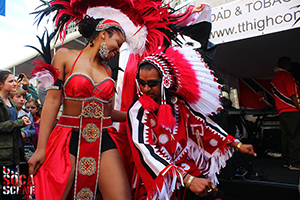
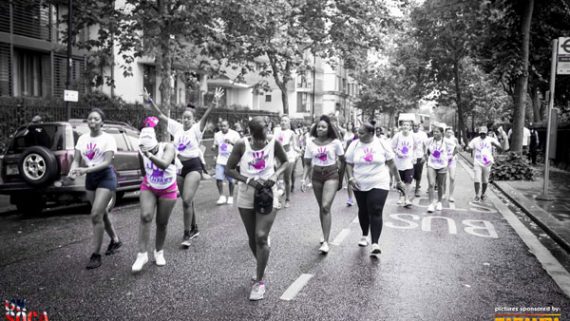

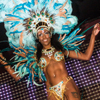
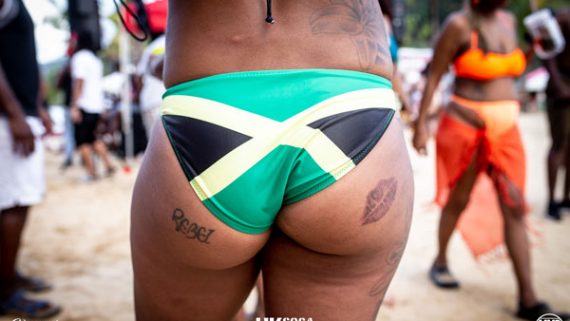
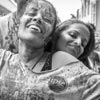
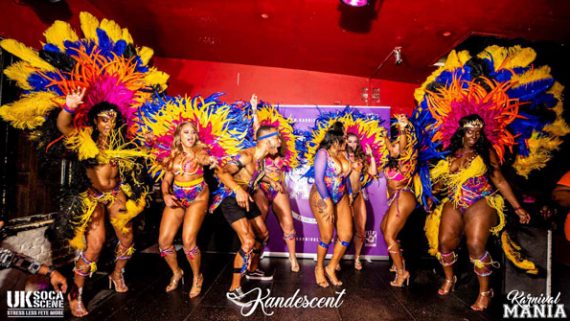
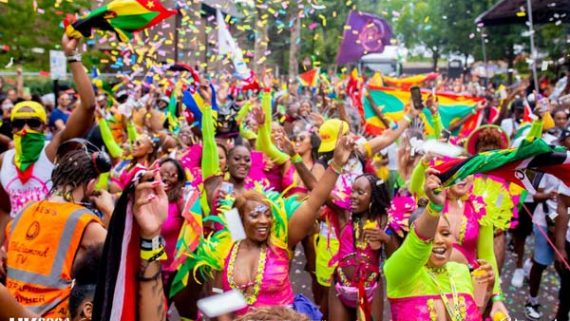

Comments
No comment yet.